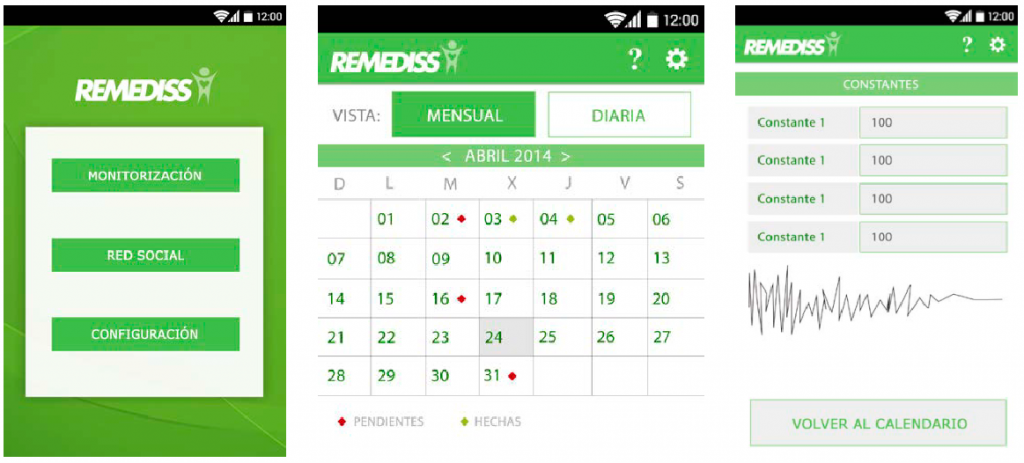Applications for e-Health
Introduction
Over the years, Multimedia Communications Group has worked on various projects in the field of e-Health. In this sense, some of the main applications developed have been:
- Development of application to help the diagnosis and prevention of musculoskeletal problems in the educational and work environment
- Interactive TV monitoring and remote monitoring system
- Proactive Tele-assistance for dependents
- Social sensorized medical network
Below some of the main applications developed are briefly explained:
Remote monitoring system through interactive TV
The system developed allows users to be passively monitored using non-intrusive sensors (position sensors, vital signs, electromyography, etc.) as well as in the case of rehabilitation, users can perform controlled exercises with medical experts. In addition, the availability of a system of video-meetings allows to maintain direct communication with patients through the TV as an interface.
The developed system allows to improve the diagnosis and to offer the most effective therapy to achieve a rapid rehabilitation of the patient. A television and Internet access are the only necessary tools to unite doctors and patients in the processes of rehabilitation of muscular ailments. The system is specially designed for patients with back pain that may have mobility problems. From home they can receive diagnosis and treatment.
With this new development, it fills the space that exists between the services that we receive today through the broadband accesses (television, Internet and voice) and what will be the future immersive television.
The patient has at his home a television receiver (IPTV) that allows the execution of interactive applications, as well as various medical sensors related to his ailments (electromyographs, glucometers, pulsometers, etc.). Thus, what the user sees through the TV is an application where you can, on the one hand, enter data into a questionnaire -vital for the therapeutic specialists to better understand the habits of the patient-, send information on the medical data captured and finally users can also visualize the results that the specialist has generated for that particular patient, all through the television and the remote control.
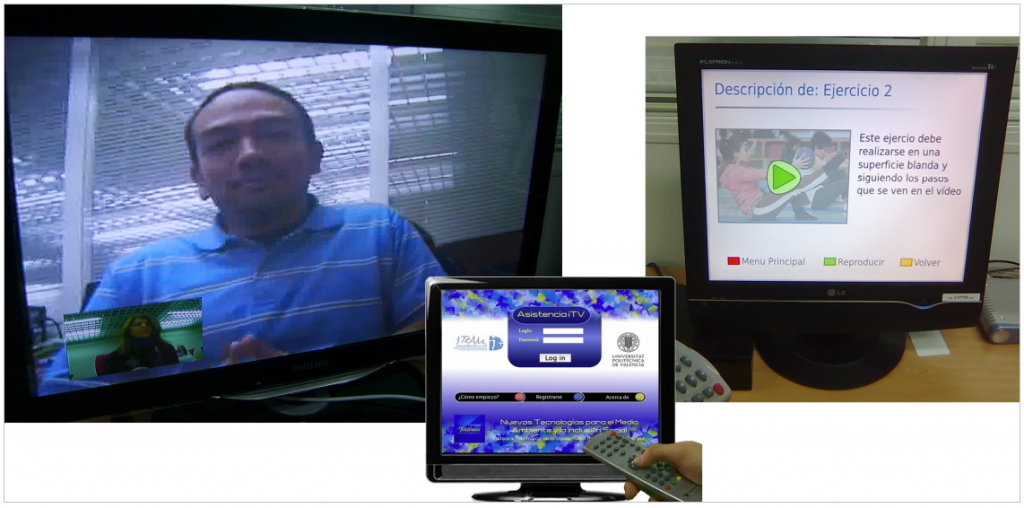
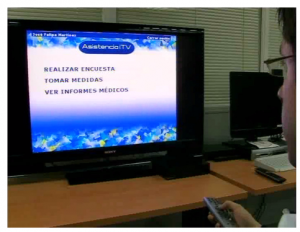
The doctor can expand their prescription through exercises, videos or multimedia guides that the patient can see in a personalized way, or even through questionnaires that the same patient can fill out from their house. In addition, the system has a module that allows communication between therapists and patients in video format. This communication based on videoconferencing is done through the television, taking advantage of the connectivity offered by the IPTV service.
Following videos show the system in operation (audio in Spanish).
Elderwatch: Proactive teleassistance for dependent people
ElderWatch represents a remotely controlled tele-assistance system based on the use of mobile devices. The proposal is built on two pillars:
- The system does not have to be manipulated by the person to whom the service is offered.
- Communication with the user must be able to be done through speech without the user having to remember to take any action. That is, the system itself can initiate communication with the user to verify that he /she is well.
The proposed solution is based on the placement of mobile terminals placed by the different rooms of the user’s house. These terminals act as sensors and serve to detect calls for help / relief by the user. That is, the application warns that an alert condition has occurred when the user requests help.
Also, terminals perform monitoring to the user. To that extent, the cameras of the mobile devices are used. In addition, Elderwatch can check if the user responds to certain calls, asking the user with a certain periodicity if he/she is well. If he/she does not respond to calls, the system considers this as an alert.
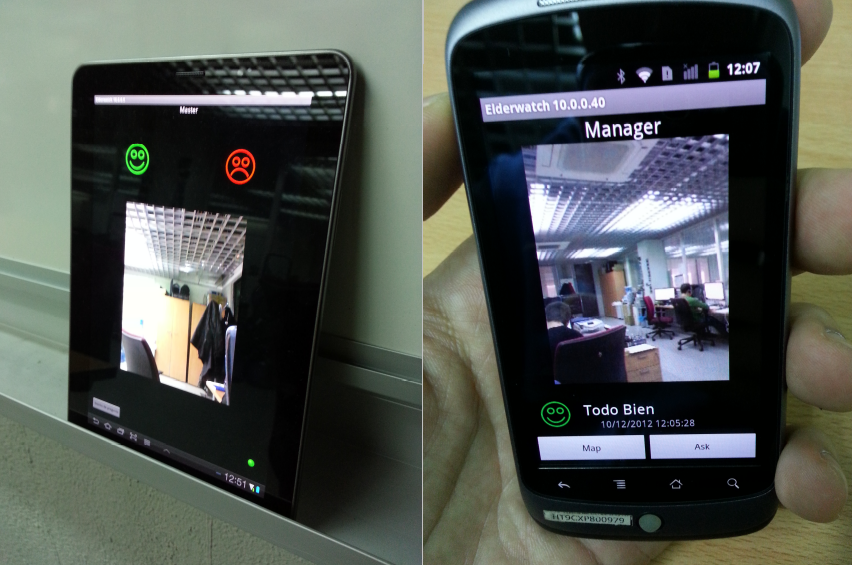
Elderwatch’s interface is extremely simple. It is based on voice and a graphic interface of two buttons: a smiling green face and a sad red face. Elderwatch is at all times listening to a distress call. The moment it detects it, it sends an alarm. The alarm goes to the Smartphone of who is in the care. This person receives a message with the time that has occurred and a photograph of the device that has detected the request for help. In addition, Elderwatch is designed to ask simple, periodic questions. If the questions are not answered within a period of time the system sends an alarm. Regardless of the alarm status, the caregiver may ask Elderwatch to ask the dependent person a question to see if he or she is feeling well. It is also possible to access in real time each of the cameras of the devices installed in the house. The following are different screens of the interface:
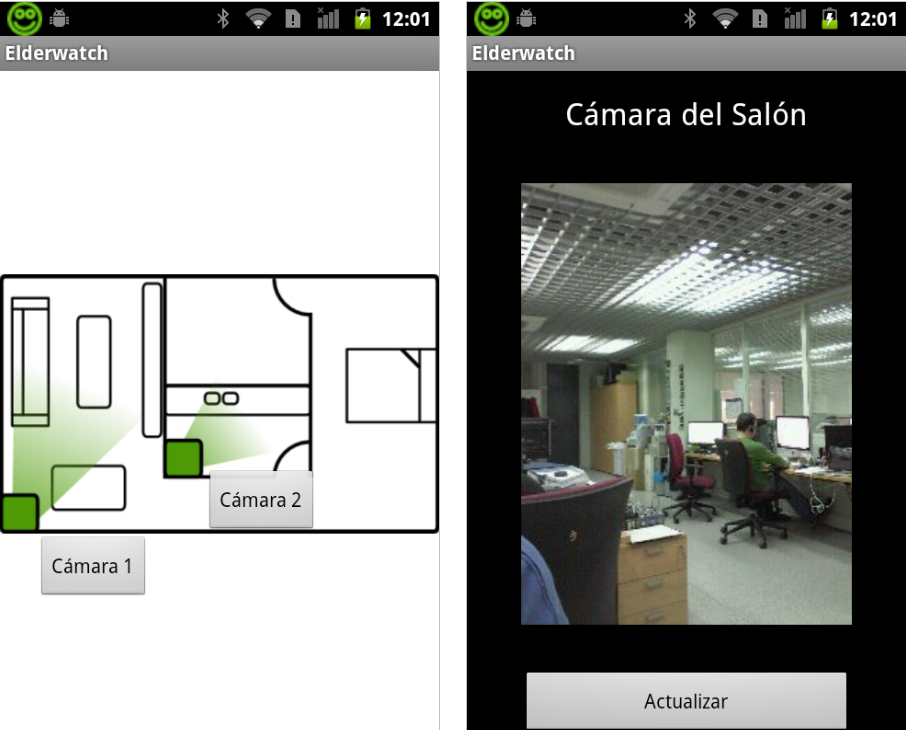
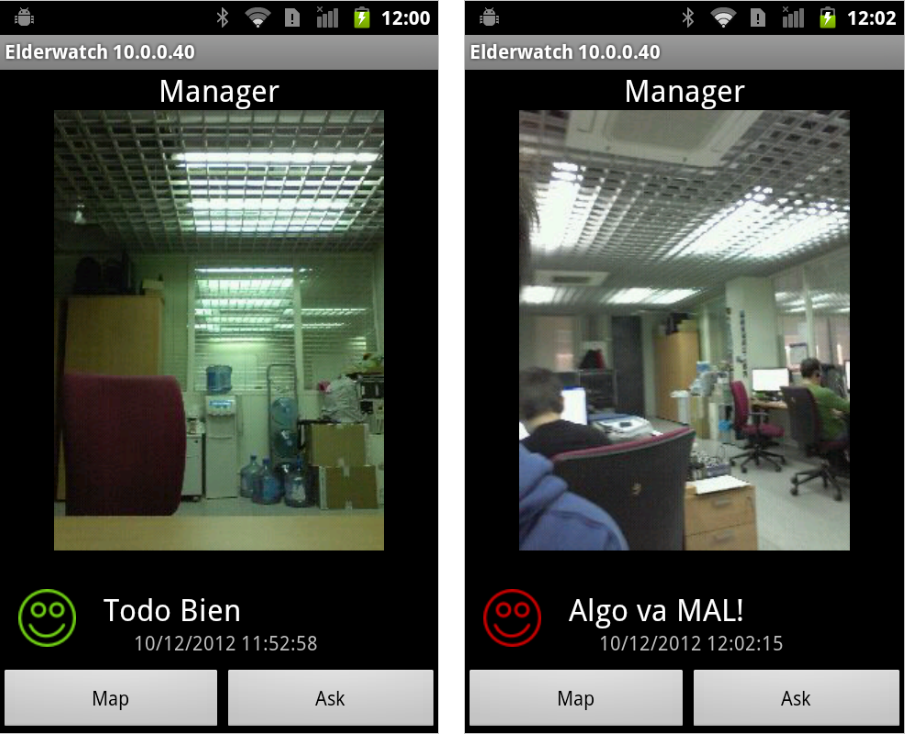
The following video shows the functionality of the system (audio in Spanish).
In an extended version, the use of biometric sensors such as heart rate meters has been integrated. Thus, in the case of detecting an anomaly, an abnormal descent or rise of the pulsations, the application sends a warning to the relative with the information of the incidence, as you can see in this video (audio in Spanish).
Social sensorized medical network
Within the REMEDISS project, it is developed a system that facilitates the follow-up of patients from their homes. The system is composed of a vertical social network that groups the information of each patient allowing to connect each patient with his doctor remotely. The development of the project involves the integration of information collected by sensors within the social network. To this end, it is contemplated that the medical center may provide each patient who requires a set of devices composed of a Gateway (mobile device or dedicated device that integrates different interfaces Wi-Fi, bluetooth, etc.) and the sensors required to measure the necessary parameters of each patient.
REMEDISS also provides the interfaces necessary for therapists to enter their questionnaires, define how they want to manage the biomedical data capture, and draw up work plans. The platform supports the representation of elements (questionnaires, data, etc.) in multiple devices (TV, mobile, PC), thus abstracting all the technical complexities inherent in the deployment of tele-assistance services in domestic or work environments. REMEDISS also allows therapists to integrate audiovisual content into work plans, as well as communicate directly with end users via video conferencing.
Below some screens of the developed app are shown:
